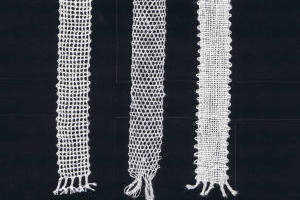
Basic stitches
Cloth stitch: cross, twist, cross
Half stitch: cross, twist
Whole stitch and twist: cross, twist, cross, twist
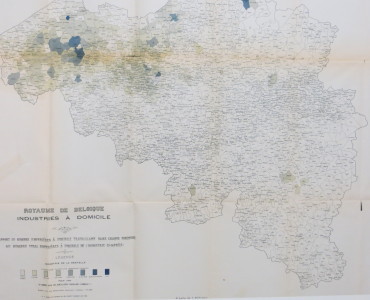
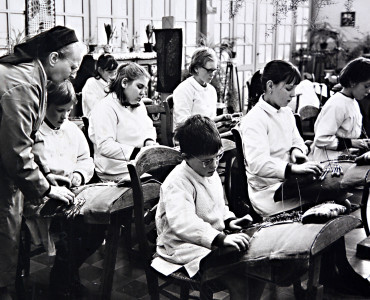
LACE, A RICH TRADITION
Bruges and lace
Lace was born in the 16th century. At first mothers would teach their daughters to make bobbin lace; lace schools were soon opened everywhere. In Bruges there were various large lace schools, such as the Foereschool and the Apostoline Sisters’ lace school. If the teaching of lacemaking started out as a means of giving poor households the means of earning a living, over the centuries it evolved into preserving a unique pastime. However, lace and lace history are also particularly important for tourism in the town. The lace sector is still today one of the contributors to tourism to which the municipal authorities pay particular attention.
The Kantcentrum: thanks to the Apostoline Sisters
The Kantcentrum originates in the Apostoline Sisters’ lace school. The nuns founded the Kantcentrum bzw (not-for-profit organisation) in 1970 in order to give new impetus to lace teaching. Two years later the not-for-profit organisation restarted the lace school. Meantime the sisters had disappeared from the organisation. In 2014 the Kantcentrum moved from the historic convent buildings on the Adornes estate into the Apostolines’ former lace school (on the same estate). The Kantcentrum now delivers lace courses, runs its own publishing house for books and lace patterns and organises lace workshops. It has brought out its own lace magazine in 4 languages since 1978 and organises lace teacher training. The Kantcentrum has evolved into a centre of excellence for lace in its widest sense which has a worldwide reputation.

Cloth stitch: cross, twist, cross
Half stitch: cross, twist
Whole stitch and twist: cross, twist, cross, twist
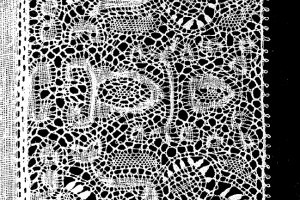
Lace group: continuous lace
Origin: evolved in the 17thcentury from Old Flemish continuous lace
Ground: many snowflakes and confusing ground with all kinds of réseaux
‘Close’ areas: cloth stitch, here and there an accent in half stitch
Designs: abstract; concealed, repetitive motifs; flowers; stems; animals
Decorative features: decorative grounds; picots on the edge, scalloped edges or footside; “toveressenwerk” (witch lace/point de fée/fairy stitch) when there are very many square tallies and when worked with very fine thread.
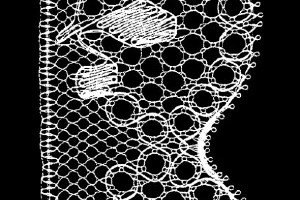
Lace group: continuous thread
18th century lace
Ground: reseau of fragile tulle
Motifs: colth stitch with workers in thick silk, give a satin sheen
Designs: flowers, festoons of leaves
Decorations: small openings and ornamental filling stitches
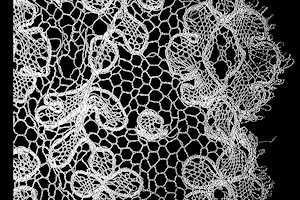
Lace group: continuous thread
Appeared first in the region of Chantilly in the 18th century
Made of black silk thread, more rarely of white silk
Ground: lille reseau
Motifs: halfstitch defined by a decorative gimp
Designs: floral sprays, large pieces of lace being worked in sections and invisibly joined afterwards
Decorations: delicate fillings within the motifs
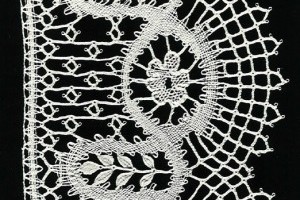
Lace group: continuous thread
Based on ancient cutwork from de Musée de Cluny
Ground: plaited bars, brides
Solid parts: wholestitch, halfstitch, wholestitch and twist
Decorations: small picots, wheatears, venetian plaits
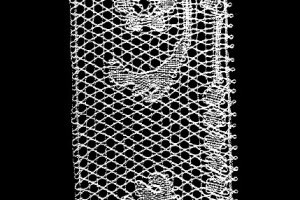
Lace group: continuous thread
Originated around Paris in the 18th century
Ground: hexagonal mesh ground
Motifs: wholestitch outlined by a gimp
Designs: flowers, leaves, garlands, animals
Decorations: inner spaces of the motifs enriched with decorative fillings, rose ground, tallies, peas, bordered with picots
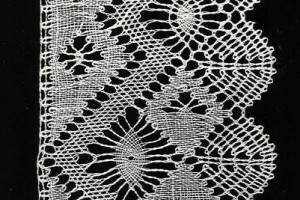
Lace group: continuous thread
Simplest type of lace derived from its forerunners
Ground: simple and composed reseaux
Motifs: wholestitch, halfstitch, twisted stitch
Designs: variety of geometric patterns
Motifs: spiders, fans, palmettes, occasionally tallies and gimp thread
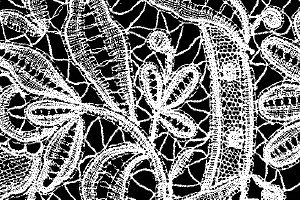
Lace group: part lace
Origin: evolved from 18thcentury Brabant and Brussels part lace and can be seen as a revival of Old Flemish part lace which dates from the mid-19thcentury.
Ground: the parts are often linked with plaits, with or without picots.
‘Close’ areas: alternating cloth stitch and half stitch
Designs: very typical small flowers, trefoils, stems, leaves and small ball shapes
Decorative features: gimp surrounding motifs, relief through raised veins, square tallies as flower centres
Brussels Duchesse always has a needle lace medallion (point de gaze) which is sewn into the lace.
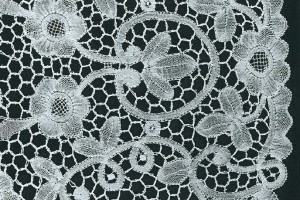
Lace group: part lace
Origin: evolved from the 18thcentury Brabant and Brussels part laces.
Ground: plaits with or without picots, twisted pairs
‘Close’ areas: motifs in cloth stitch, half stitch and cloth stitch with twist
Designs: flowers, leaves, stems,… swans and animal figures. Usually the design contains natural elements or a natural scene.
Decorative features: leaf-shaped tallies, openings.
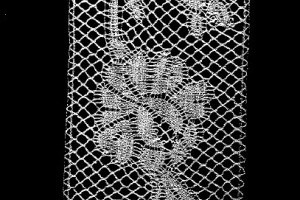
Lace group: continuous thread
From the town of Valenciennes second half 17th century
Ground: Bruges Valenciennes round meshes, Yper Valenciennes square meshes
Solid parts: a continuous line of tiny holes outline part of the motifs
Design: motifs borrowed from nature: flowers, leaves, garlands, animals
Decorations: oeil-de-perdrix fillings, peas, bordered with picots
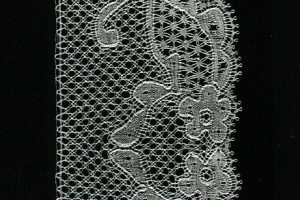
Lace group: continuous thread
Result of slow evolution from the Flemish laces of the 17th century
Reseau: five-hole ground or Flanders ground
Motifs: wholestitch outlined by a gimp
Designs: flowers, garlands, animals
Decorations: partridge eyes, snowflakes, peas decorate the toilé and reseau, bordered with picots
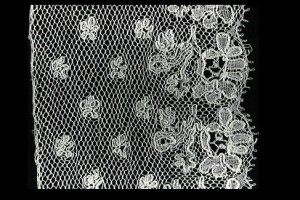
Lace group: continuous thread
Originated in the 18th century
Ground: hexagonal mesh “ijsgrond”
Solid parts: wholestitch encircled with an outlining thread
Motifs: borrowed from nature
Decorations: square points d’esprit, decorative fillings in and between the flowers, bordered with picots
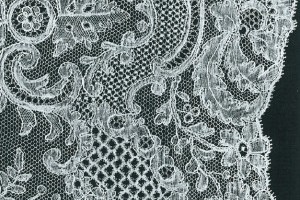
Lace group: continuous thread
Simplified version of the Mechlin lace, popular in the second half of the 19th century
Ground: hexagonal mesh “tule”
Motifs: wholestitch surrounded by an outlining gimp
Designs: mostly flowers
Decorations: decorative fillings, eyelets in the motifs, rose ground, tallies, bordered with picots
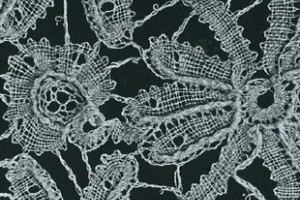
Lace group: part lace
Origin: developed from Duchesse at the end of the 19thcentury and can be seen as a bobbin lace imitation of the 17th century Venetian needle lace with the same name.
Ground: bars of varying lengths with or without picots.
‘Close’ areas: main motif is a small, 3 or 5 petal rose worked in cloth stitch with an eyelet. In addition we find scrolls, small fish, beans, and leaves
Designs: garlands of small roses, floral scenes
Decorative features: openings, light decorative grounds as well as point ground and honeycomb, a bit of half stitch. Rosaline perlée has a “pearl” worked in needle lace in the centre of each small rose.